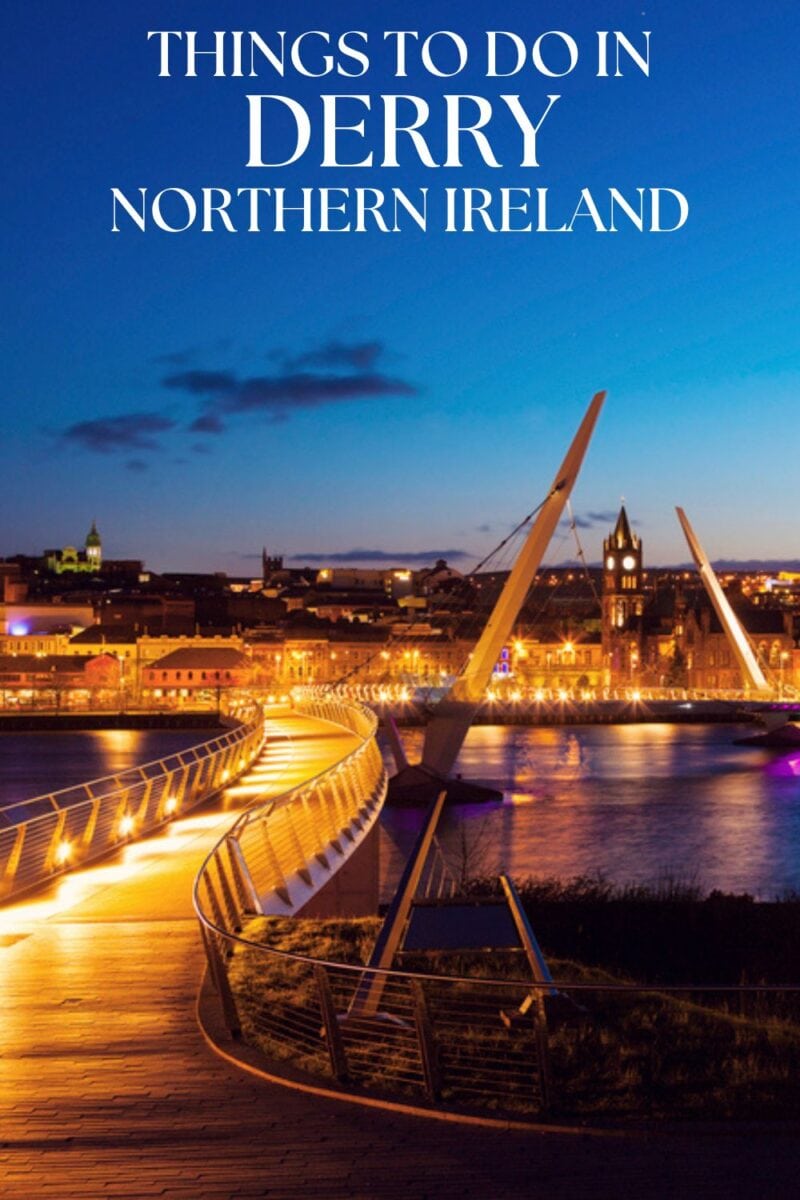Things to do in Derry the ultimate guide
Visiting Derry or Londonderry Northern Ireland as it’s “officially” known is something I do quite often. Ireland’s only completely walled city of Londonderry (and Northern Ireland’s second largest city) is often overlooked and extremely underrated for folks visiting Ireland and yet it is one of my favourite cities in the country. County Londonderry is where the Wild Atlantic Way Meets the Causeway Coastal Route. I’ve put together an itinerary for visiting Derry that you can do in one day and it includes 16 things to see in Derry (Londonderry) that you shouldn’t miss.
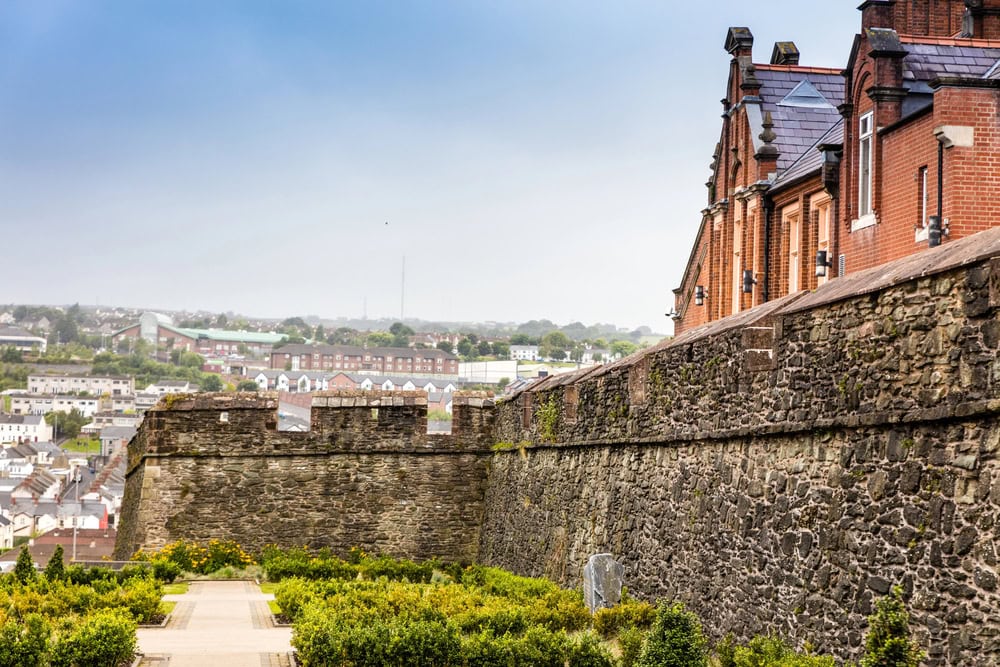
Derry is the second biggest city in Northern Ireland and is located in County Derry which borders Donegal and has close ties to the County. Its name Derry comes from the Irish word Daire which means oak forest. Derry is the only remaining intact walled city in Ireland. The old city which is walled is on the west bank of the Foyle River and is spanned by two bridges for vehicles and the pedestrian bridge named the Peace Bridge.
Derry, known as the Walled City, is a must-visit destination in Northern Ireland. Steeped in history and culture, this city offers tons of activities and attractions that cater to a wide range of interests. From exploring the ancient walls that encircle the city to strolling along the scenic River Foyle, there is no shortage of things to do in Derry.
One of the highlights of visiting Derry is the opportunity to immerse yourself in the literary history of the city. Home to famous writers such as Seamus Heaney, the Nobel Prize-winning poet, Derry has a rich literary heritage that continues to inspire visitors from around the world.

For outdoor enthusiasts, Derry is a paradise. The city is located along the Causeway Coast, offering breathtaking views of the rugged coastline and the iconic Giant’s Causeway. Hiking, cycling, and water sports are just a few of the activities available for those looking to explore the natural beauty of this region.
Whether you’re interested in history, culture, or outdoor adventures, Derry has something for everyone. So why not plan a trip to this vibrant city and experience all that it has to offer?
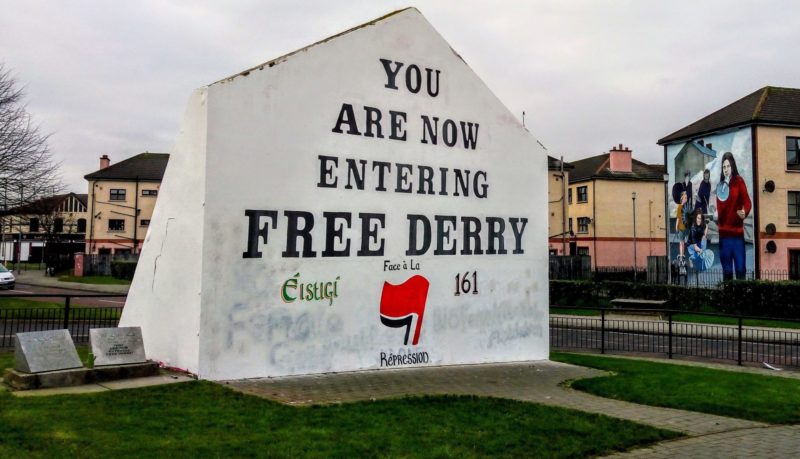
There is a lot to see and do in Londonderry Ireland, the city holds a lot of history from the ancient oak forests that were plundered by the British to the Troubles and Civil Rights marches and the best city walls in Ireland.
- Things to do in Derry the ultimate guide
- Derry Faqs
- Is it Derry or Londonderry?
- A brief Derry history
- Derry Tourist Map
- Londonderry Ireland
- Getting to Derry (Londonderry)
- Things to do in Derry in 2 days
- A tour of Bogside – Free Derry, Murals, Bloody Sunday Memorial
- Free Derry Corner
- Bloody Sunday Memorial
- Museum of Free Derry
- Derry walking Tours
- Derry City Walls
- Visiting the Guildhall in Derry
- The Craft Village of Derry
- The Derry Peace Bridge
- Tower Museum Derry
- Check out the gold teapot
- Guildhall Taphouse – Artisan Brewers of Dopey Dick Beer
- The story of Dopey Dick
- Siege Museum of Derry
- The Heritage Tower – Former Derry Gaol
- Derry Girls Mural
- Derry Halloween events
- Tourist Information Centre Londonderry
- Where to stay in Derry
Xyuandbeyond is reader-supported. When you buy through links on our site, we may earn an affiliate commission. You can read my privacy policy here.
101 Landmarks in Northern Ireland
Derry Faqs
Is Derry worth visiting?
Derry is one of those Northern Ireland cities that everyone should visit. Smaller than Belfast it is rich in history and culture and there is some mighty craic to be had in the pubs. From Derry you can also take the ferry across to the fabulous Inishowen Peninsula, Donegal’s wild untamed northern Wild Atlantic Way Coast.
Is Derry Catholic or Protestant?
Although Derry was originally an almost exclusively Protestant city, it has become increasingly Catholic over recent centuries. The 1993 census of Derry said that nearly 70% of Derry’s citizens were Catholic.
Is Derry a friendly city?
Derry has been named as the eighth friendliest city in the UK, with Newcastle coming in at number one. Thousands of tourists flock to Derry for events such as Halloween celebrations.
What are the top attractions to in Derry London~Derry?
Derry Attractions include the Derry City Medieval Walls, the Bloody Sunday Memorial, The Derry Murals, the Peace Bridge and of course the Derry Girls Mural.
What should I not miss in Londonderry?
TTake a guided tour of Bogside – which will include the Free Derry, Murals, and the Bloody Sunday Memorial. These tours will teach you a lot about the ‘Troubles’ and how the citizens of Derry are moving into a peaceful future. You can also enjoy a good draft of beer in the Walled City Brewery or simply take a stroll around the ancient walled city of Derry.
Is it Derry or Londonderry?
I should say a word or two here about the Derry Londonderry naming issue. Nationalists favour Derry and Unionists use Londonderry. The name of the city didn’t use to be contentious but in the ’60s at the start of the Troubles, it was politicized by the Republicans to drive home the fact that Ireland should be united and not under the control of London.
The argument to change the official name from Londonderry to Derry has gone back and forth for years. Hopefully with a much younger voting group coming up and the Peace Accord going strong eventually the name will become in law Derry which is its original Irish name.

A brief Derry history
Derry is one of the oldest continuously inhabited places in Ireland whose earliest records stretch back to the 6th century. A monastery was founded here by Saint Colmcille who came to Derry from Donegal to help convert the occupants to Christianity.
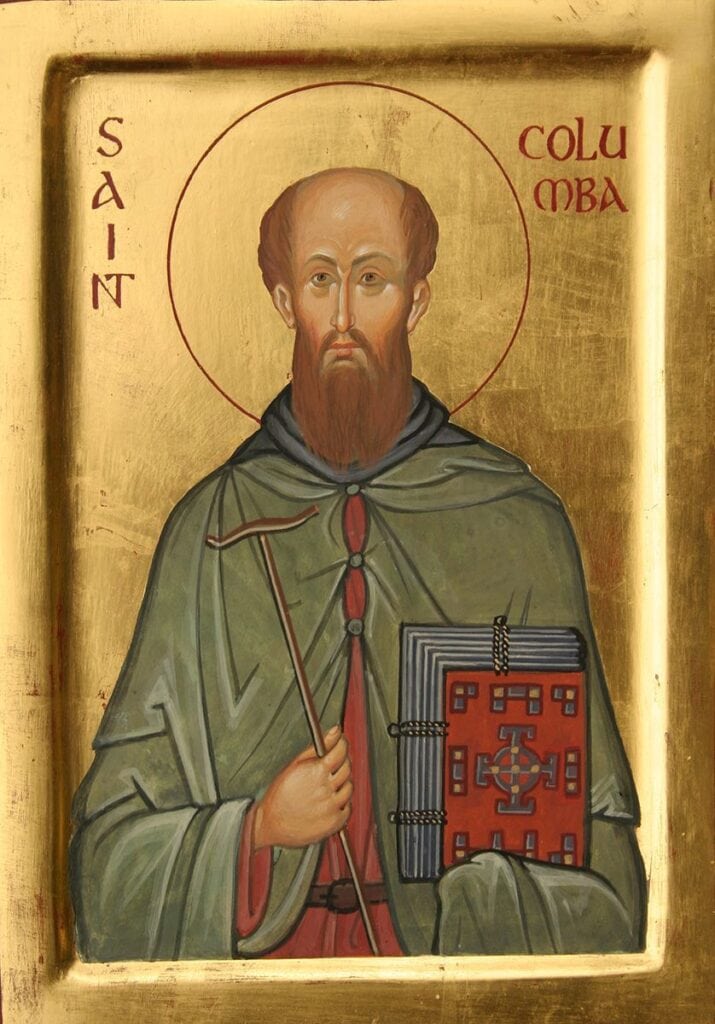
Derry is famous for its old intact city walls which surround the old city which lies on the banks of the River Foyle. This one mile of city walls are known as one of the best examples of a walled city in Europe.
1609-1613: After the de-population following the Nine Years War and the Flight of the Earls, the Plantation of Ulster begins. Derry is renamed Londonderry due to the involvement of the Guilds of London in its development. With its imposing walls and new Protestant Cathedral (1633), Londonderry was intended to be a bastion of British power.
1688-1689: Siege of Derry. Thirteen Protestant Apprentice Boys close the gates on the Catholic King James, with a bitter 105-day siege following. There is a great loss of life before the siege is lifted.
1968 onwards: Outbreak of The Troubles in Northern Ireland, with Derry at its centre. Civil Rights demands by the city’s Catholic majority lead to violence, with Bloody Sunday, on 30 Jan 1972, seeing 14 unarmed Catholic civilians shot dead by British Paratroopers, an event which remains emotive to the present day. During this time, the city sees a great exodus of the Protestant population to the East of the river. In Your Pocket
60 Best Northern Ireland tourist attractions
Derry Tourist Map
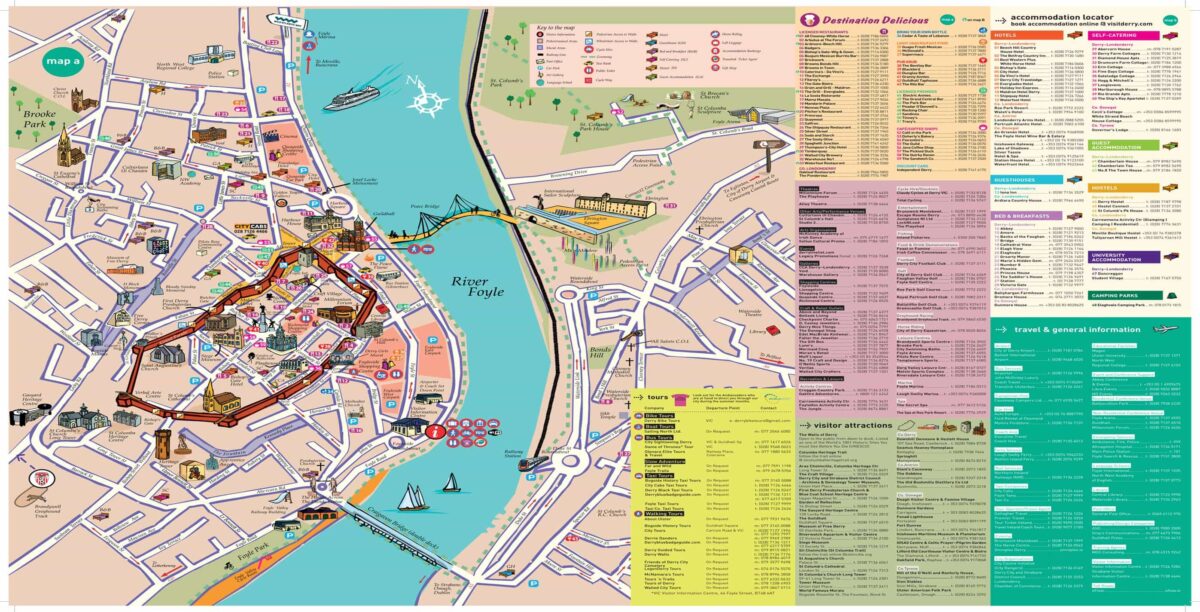
Londonderry Ireland

Fancy a visit to Ireland? Well here is everything you need to know about visiting Ireland
Getting to Derry (Londonderry)
If you are touring the Causeway Coast then your itinerary will probably end up in or near Derry. Visiting Derry is an easy trip from Belfast. The train takes about 2.5 hours, a bus via Translink is around 2 hours (that depends on stops) or by car which is around 90 minutes.
Getting to Londonderry from Dublin by driving takes around 3 hours. Translink UK operates a bus from Dublin to Derry every 3 hours.
You can also fly into Derry Ireland Airport from the UK or into Belfast where you can rent a car. The George Best Belfast City Airport and Belfast International Airport both take flights from the UK and of course, the international airport takes flights from the US and other areas of the world.
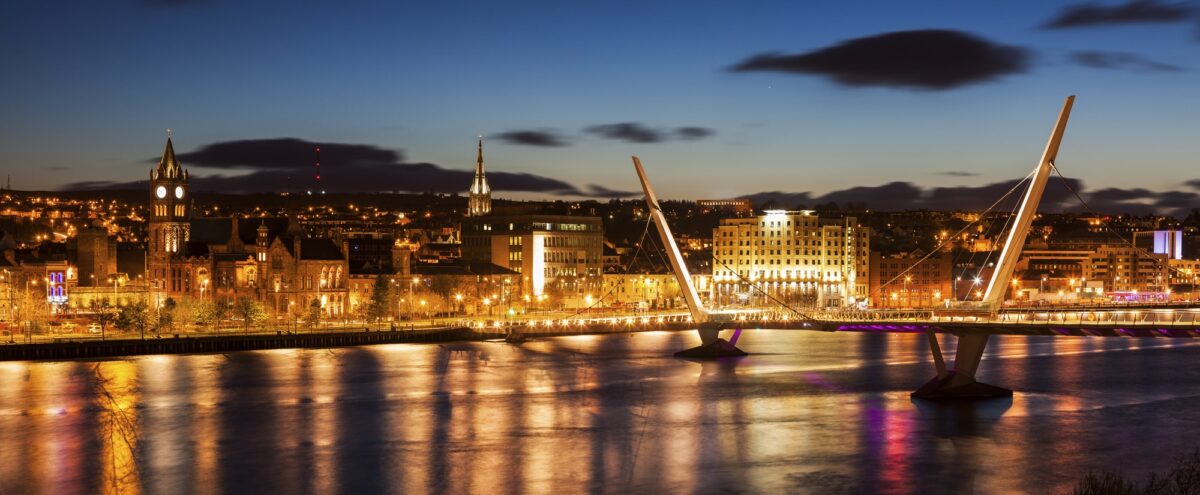
Since we live in Donegal we recommend flying into Donegal Airport, which has been voted as the most scenic landing in the world and it means that you can add Donegal to your itinerary.
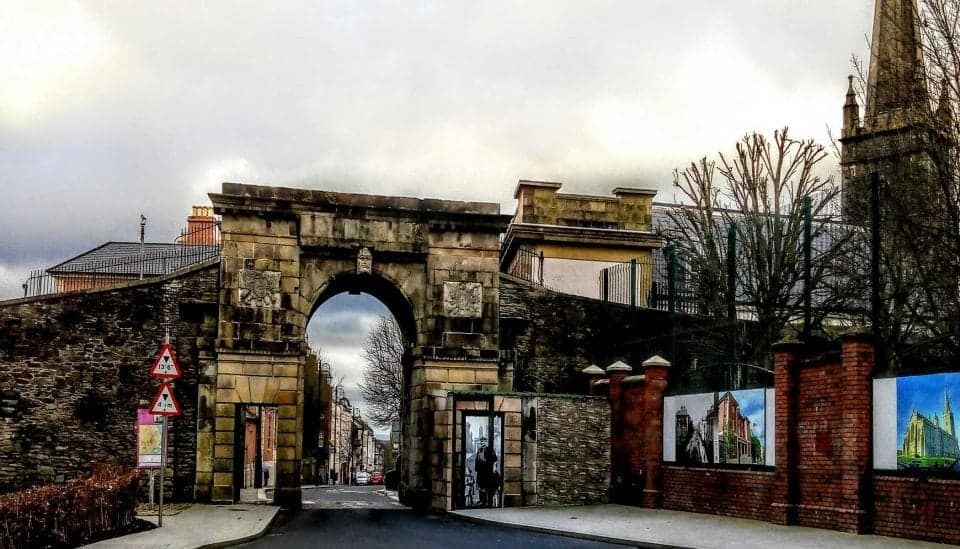
We wanted to take the Derry Hop On Hop Off bus but when we made it to the visitor’s centre we learned that it only runs in season…sigh… from mid-March until the end of October. So, the Centre recommended a tour with a cab and arranged it for us right then and there. The cost was pretty much the same as the Hop on Hop off bus around £25 for the two of us. Our tour guide was Adrian Callan who was absolutely brilliant and made us forget everything about doing a bus tour.
Adrian was born in the Bogside and was an actual witness to events during the “troubles”, Bloody Sunday and all the horrific times that nearly destroyed this city. Adrian is an absolutely superb guide and raconteur – he knows his history and tells you stories that are not one-sided and cover the gamut from the good to the bad to the ridiculously funny.
Adrian Callan [email protected] or call 0044 (0) 7793525478 the best guide in Derry.

Things to do in Derry in 2 days
We began our tour of Derry with Adrian from the Londonderry Tourist Centre (which is very easy to find and located right across the road from where the Derry Peace Bridge begins) and we crossed the Foyle over to Waterside where we toured some of the Republican and Unionist areas. You can still see the markings on the curbs in the Unionist areas and on the telephone poles for the red, white and blue of the British flag. In the Republican areas, these painted curbs and poles are becoming less and less common and we rarely saw one.

I noticed that the flags all seemed to be at half-mast and asked Adrian why that was. Adrian in typical Irish fashion wove a tale of the flags being at half-mast because they couldn’t be picked out and destroyed by snipers. Laughingly he then told us the basic truth of the matter – the flags were at half-mast because that was how high the ladders could reach.
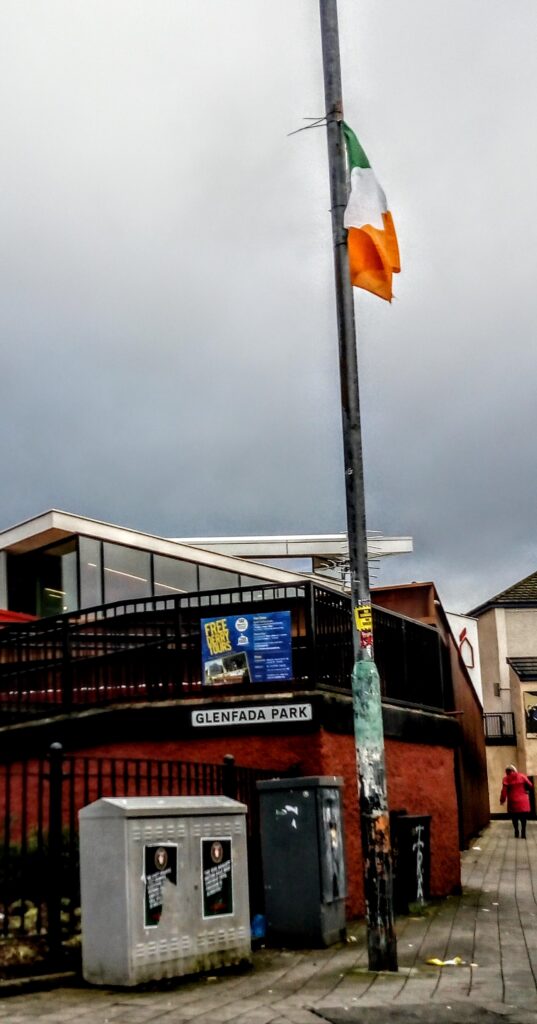
We spent around an hour and a half with Adrian and he provided us with insights and information on everything from the Spanish Armada, the division of Derry from Donegal, and the ancient civil wars and early days of the founding of Derry.
Adrian was by far the best guide we have ever met and we would highly recommend you give him a shout when you are in the area. He also does a wide range of tours into Donegal, the Causeway Coast, and the Glens of Antrim to name just a few. I can’t say enough good things about his experience and tours.
Crossing over to Waterside with Adrian we had a quick tour around the area and checked out the views from Eskaheen. Which gave some scope to the area with the Peace Bridge in the distance and Adrian gave us some great history lessons on how Derry came into being and how the divide was made between the north and south. He told us that Derry got its name from the fact that it was a huge swathe of oak trees that used to cover the area.
During Elizabethan times, Derry was a highly prized area for the London merchants who salivated over the oaks, which would be used to build the British naval fleets to defeat the Spanish for Queen Elizabeth. The biggest prize in Ireland was the ability to make money for the British from these magnificent and now long-gone forests.
From Waterside and the striking views of Derry from this higher vantage point, we then visited the Cemetery.
Touring The City of Derry Cemetery
The cemetery is on a hill with views over the Foyle River and Derry city itself. There were IRA graves there, victims of Bloody Sunday, Hunger striker memorials and graves as well as just ordinary folk. We were very surprised to see graves belonging to Canadians from WWI and WWII decorated with little Canadian flags in memoriam. It was a really quiet, peaceful place to be with magnificent views over the city.
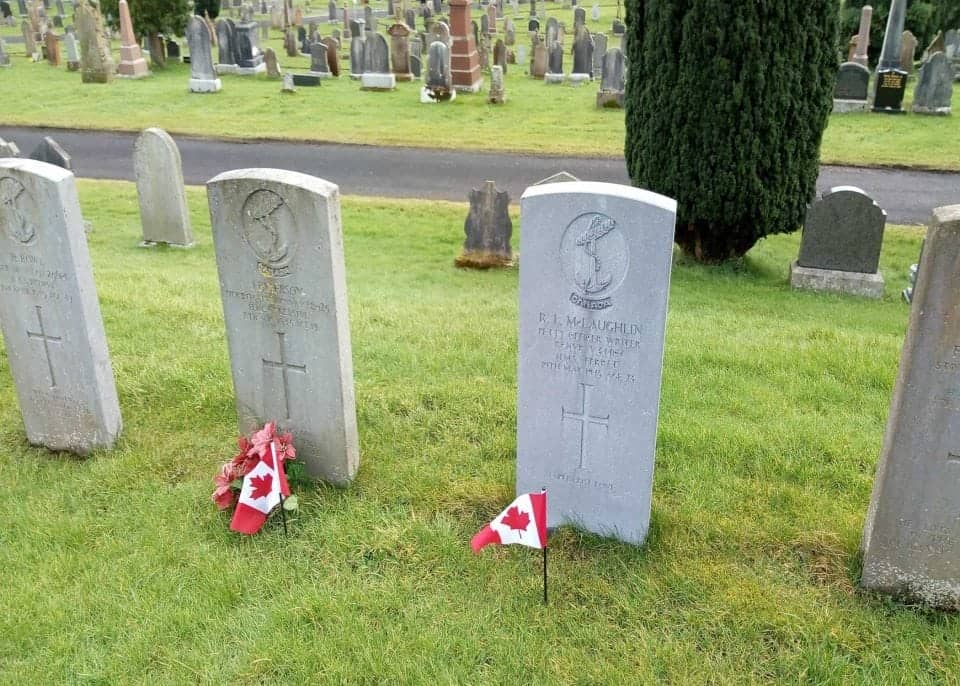
From the cemetery, we then took a drive back over the Foyle to visit and tour the Bogside area of Derry. Adrian our guide grew up in this area, was incredibly knowledgeable, and freely shared his experiences of growing up here.
A tour of Bogside – Free Derry, Murals, Bloody Sunday Memorial
We began by taking in some of the murals that are on the gable ends of houses in Bogside. The Bogside Artists have painted all these murals and there are 12 of them in total over time these murals have become known as The People’s Gallery.
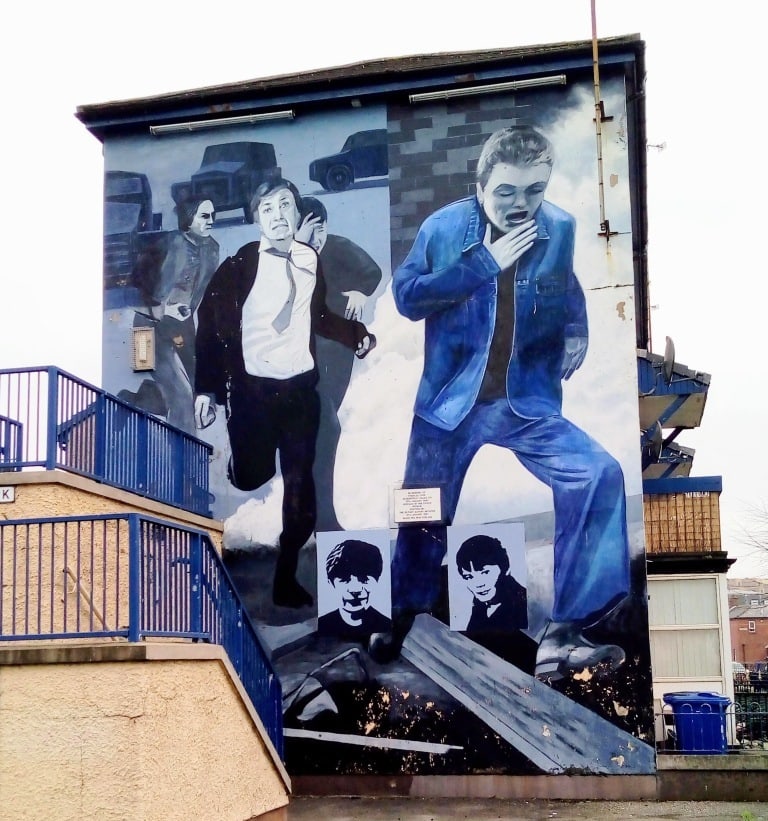
Painted between 1997 and 2001 the murals are a commemoration of the events of the troubles in the Bogside. The murals include Bloody Sunday, Battle of the Bogside, Operation Motorman, and the hunger strike that took place in 1981.
Free Derry Corner
First painted by teenager John Caker Casey in 1969 on the gable end of terraced houses which have now gone. The name ‘Free Derry’ was given to those areas barricaded off from the security forces from 1969 -72. The barricades were removed during Operation Motorman. This street art is often added to with slogans relating to current events.

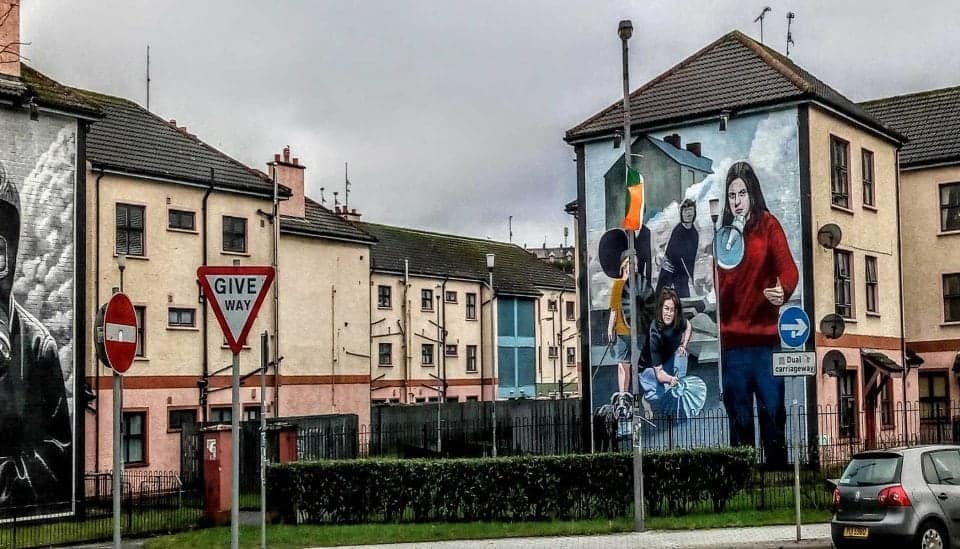

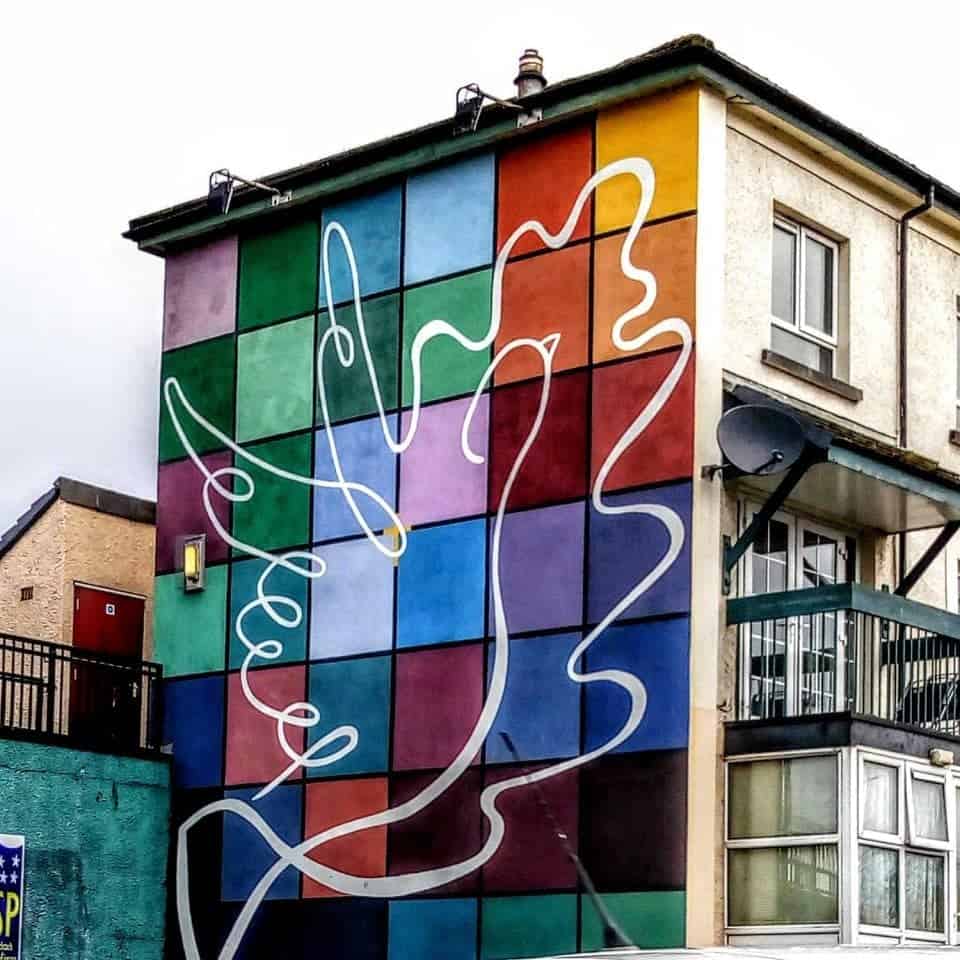
Bloody Sunday Memorial
A simple granite obelisk is surrounded by a small cast iron fence and a plaque that explains the Bloody Sunday massacre that took place here in 1972. Piles of flowers are left daily in remembrance of the event and the victims.

We have all heard the U2 song but it just doesn’t capture the pathos of standing at that monument and realizing most of the killed were young boys aged between 16 and 21.
This was a civil rights march that started out peaceful and ended up with 14 dead and many more wounded. British soldiers were essentially told to gun down innocent civilians, the majority of those killed and wounded were shot while running away from the soldiers, and others were shot trying to help the wounded. Army vehicles ran down some protestors, others were hit with rubber bullets and even more beaten with batons.

My personal favourite was, however, the Che Guevara mural. Apparently, Che’s father, whose full name is Ernesto Guevara Lynch, was proud of his Irish roots and how his family built a business in Argentina after fleeing Ireland during Cromwell’s era.

Years later when Che was Cuba’s transport minister, he made an unscheduled stop off in Limerick and wrote a letter to his father, who he thought would be pleased to hear that he was visiting a country of his ancestry
Jim Fitzpatrick an Irish artist created the famous print of Che that appears around the world on t-shirts to posters. Jim was also the graphic designer for all of Thin Lizzy’s album covers. Recently Adrian told us that since Jim never received a penny for the Che graphic he has now copyrighted the graphics and created a fund that gives all the profits from the sale of the image back to Cuba.
This mural is dedicated to the Women of Derry. Countess Markievicz, carrying a flag of Cumann na mBan, and Ethel Lynch, carrying a flag of the Derry IRA. Markievicz is famous for her role in the Easter Rising of 1916 Lynch died in December 1974 of injuries sustained when a bomb exploded prematurely.
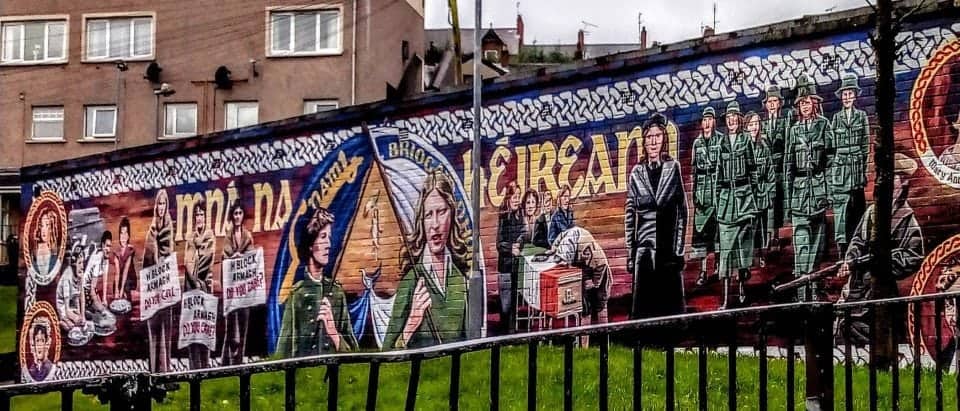
Museum of Free Derry
The Free Derry Museum concentrates on the Battle of Bogside, Bloody Sunday, and Operation Motorman which tells the story of the civil rights movement that began here. There are over 25,000 artefacts within the museum.
Derry walking Tours
Free Derry Tours is a community led initiative offering authentic political walking tours of the famous Bogside delivered by local Blue Badge trained guide. We also offer an alternative historical walking tour of Derry’s Walled City including a complimentary tour of the historic St Columb’s Cathedral. Cost of the tour is £10 per adult.
Derry City Walls
Derry City centre is surrounded by ancient walls that were completed in 1619. The Derry Walls are 8 metres high and 9 metres thick. These are the only walls in Ireland to survive virtually intact today. The walk around the walls is approximately 1.5 kilometres long.

Derry’s nickname, the Maiden City, derives from the fact that the walls have never been breached by an invader. However, as Adrian, our guide put it “these walls have divided us and will continue to do so until we deal with pulling down the parts that have been added to them”.
We learned from Adrian that a large part of the issue of division is down to the fact that kids from protestant and Catholic families still divide themselves educationally by these so-called loyalties.
An integrated education system is desperately needed in N. Ireland. Most citizens feel that with an integrated system, the old lines of Protestantism and Catholicism will be breached and overcome and peace will then be long-lasting and not as temporary as they feel it is now.
Visiting the Guildhall in Derry
Adrian dropped us at the Guildhall and encouraged us to visit the building to learn about the Plantation of Ulster and the Guildhall’s history in Derry.
Standing just outside the city walls, the neo-Gothic Guildhall was originally built in 1890, then rebuilt after a fire in 1908. Its beautiful stained-glass windows were presented by the London livery companies, and its clock tower was modeled on London’s Big Ben.
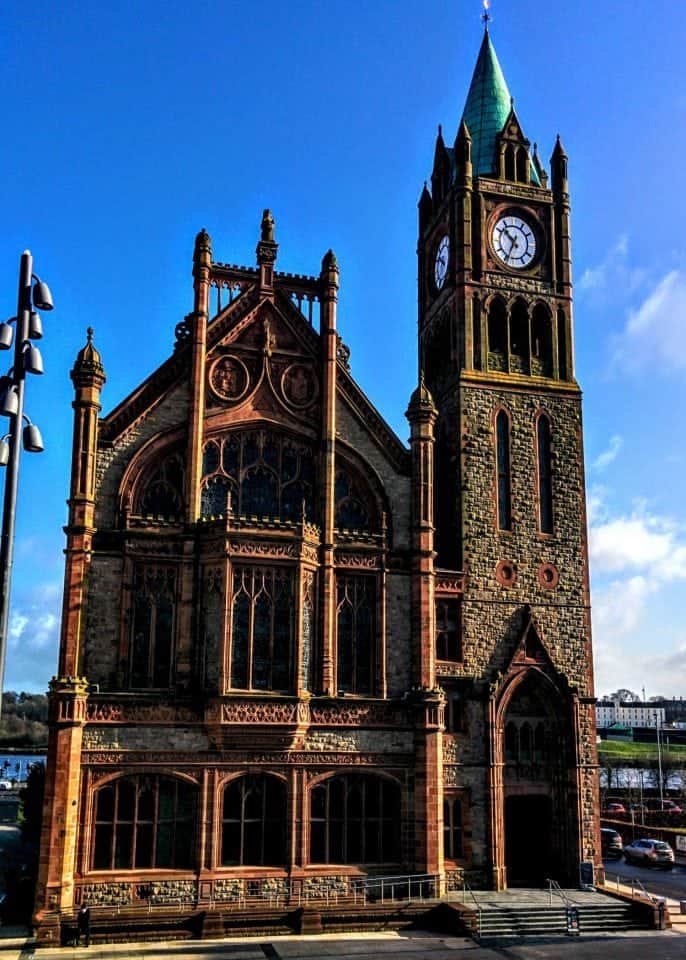
You will see a statue of Queen Victoria in the entrance hall, notice the hands are missing and the marble base has some cracks and gouges this occurred during the bombings of the Guildhall in 1972.
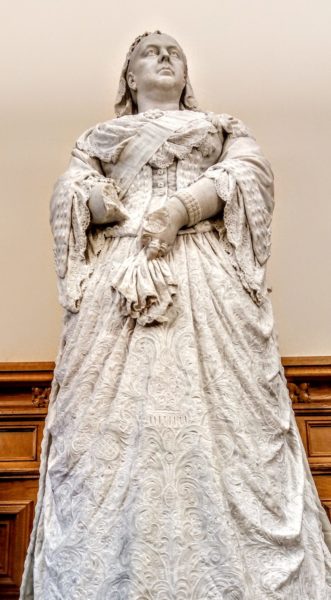
Inside, there’s a historical exhibition on the Plantation of Ulster and a tourist information point. The organ in the Guildhall is absolutely magnificent it was built in 1912 and refurbished in the 2000s. You can actually rent the main hall here for £1000 pounds for your wedding and get married on the stage where Liam Neeson had his first acting job.

The Craft Village of Derry
This is a little haven in the centre of Derry, which is a reconstruction of an 18th-century street and square. There is a central canopy in the square and it provides a wonderful arena for local performers and displays. The village itself is full of eclectic little shops and cafes with over 100 crafters operating out of the various stores.
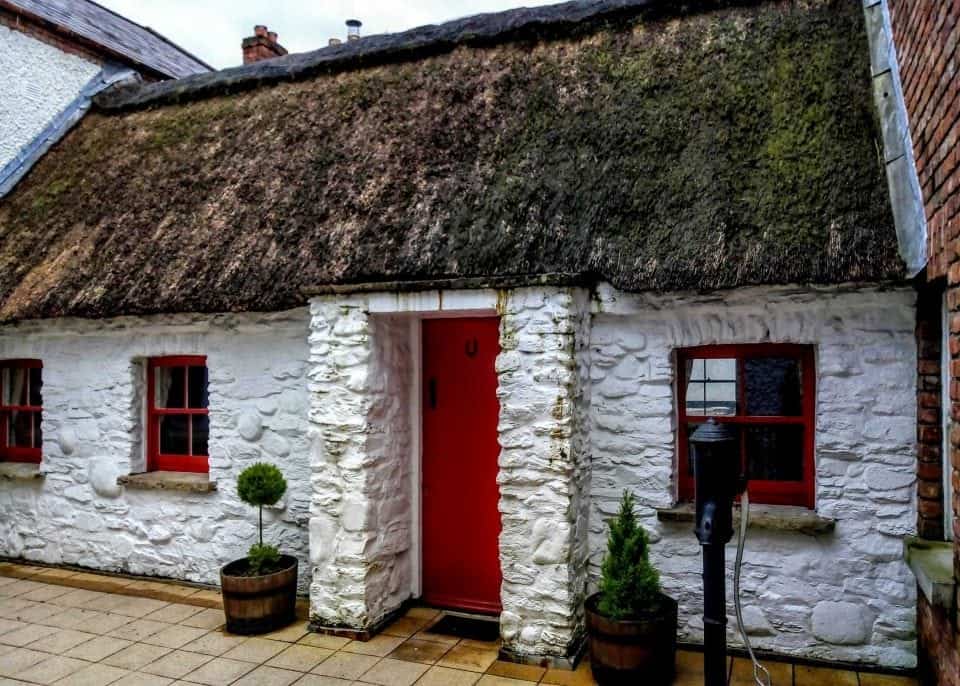
The Derry Peace Bridge
The Derry Peace Bridge has become an integral part of Derry City and has changed the way local people use and view their city with over 3 million people having crossed it so far and many of the locals using it daily. It is a universal symbol of peach that joins the two sides of a once terribly divided city.

The Derry Peace Bridge is a walking bridge over the River Foyle. It was built in 2011 to symbolize the unification of the Protestant Waterside and the Nationalist Bogside. The bridge was designed to symbolize the bridging of the 400-year-old political and physical gap between the two communities of Derry. It stretches from the Guild Hall to Ebrington Square and St Columb’s Park on the far side of the River Foyle.

Tower Museum Derry
The Tower Museum houses three permanent exhibitions.
- “The Story of Derry,” tells the colourful and dramatic history of the city from its earliest prehistory to the present.
- “An Armada Shipwreck – La Trinidad Valencera,” tells the story of one of the largest ships in the Spanish Armada, La Trinidad Valencera, which sank off the Donegal Coast in 1588 and was rediscovered by divers from the City of Derry Sub-Aqua Club in 1971.
- The Tower Museum is now also home to the Derry Girls Experience.
The top of the Tower Museum (level 5) provides the only open-air viewing facility in the heart of the city centre with stunning panoramic views of the inner city and river Foyle.

Check out the gold teapot
The gold teapot first appeared in 1866 and it advertised a new grocery business. This striking golden teapot apparently spouts steam every hour on the hour during the day. The teapot, itself weighs 74kg and it was previously hung in the city for over 100 years. It has had an eventful history and the fact that it has survived so long is remarkable
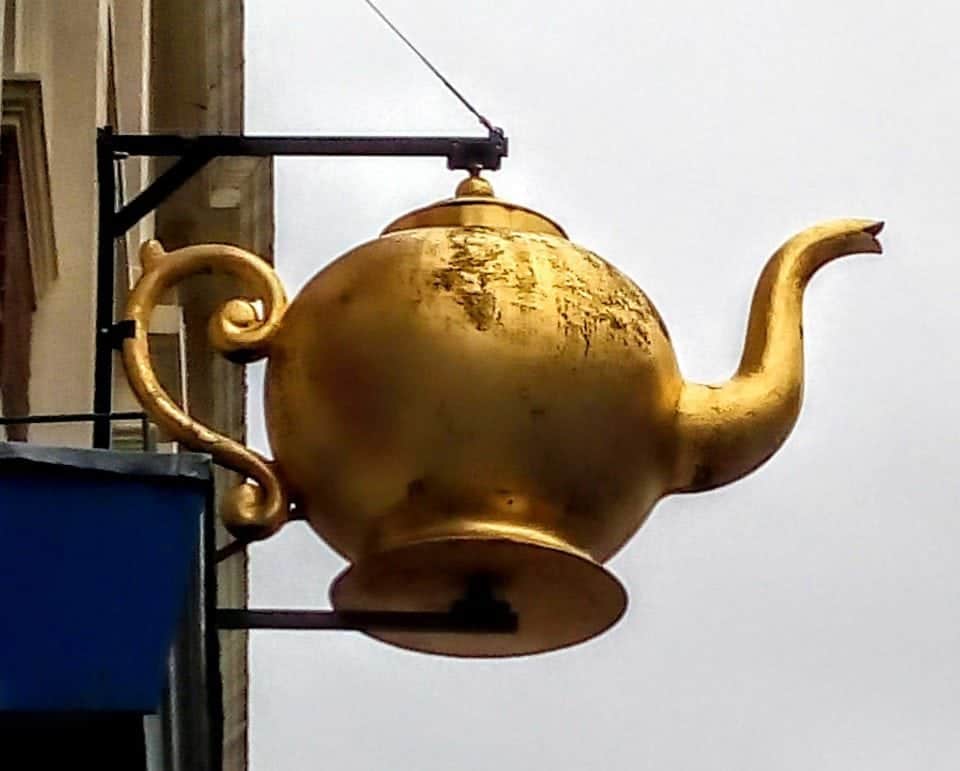
Guildhall Taphouse – Artisan Brewers of Dopey Dick Beer
When visiting Derry you have to find some artisanal beer and the Guildhall Taphouse has one of the best. Housed in a wooden-beamed, 19th-century building brightened with fairy lights, the Taphouse is a cosy place to sample an excellent selection of local and international craft beers or a sophisticated cocktail.
There’s regular live music including trad sessions every Wednesday. The Guildhall brews its own artisanal beer in-house and the beers are called Dopey Dick after a rather unique story about a whale in the Foyle River. Oh and by the way the Dopey Dick beers are excellent.
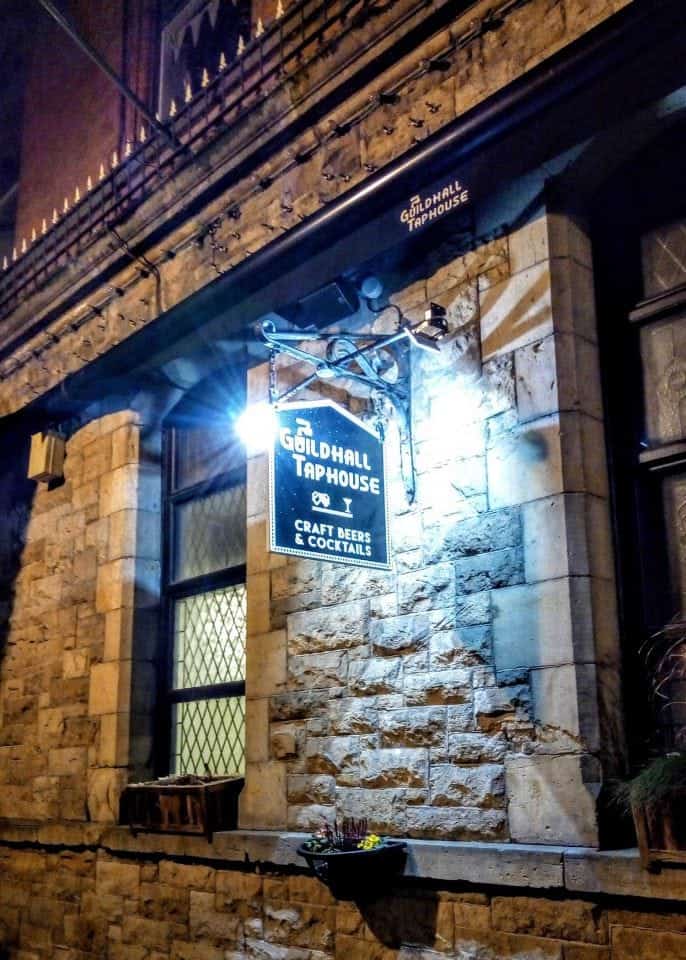
The story of Dopey Dick
In 1977 golfers, walkers, and those just watching the Foyle river flow by noticed a rather large beast swimming upriver. They could not believe their eyes when they figured out it was a whale that was over 20 feet in length.

The whale was identified as a “killer whale” and Operation Rescue was launched to herd the animal back out to the open water, but apparently, it didn’t want to go. Numerous efforts failed to encourage the whale and eventually Derry folk just got to calling it a “dopey Dick” the name stuck. Eventually, the whale tired of the Foyle and headed back to open waters on its own terms. In 2015 Dopey Dick was spotted off the coast of Scotland alive and well.
Siege Museum of Derry
This new museum celebrates the role of the 13 apprentice boys who in December 1688 locked the city gates against the approaching Jacobite army. Derry was surrounded and during the 105-day siege, no supplies could reach the city, its starving citizens resorting to eating dogs and rats until English ships brought relief.
The Heritage Tower – Former Derry Gaol
This is the last remaining tower of a former gaol, the remainder of which was demolished in 1973. While the original gaol was built in 1791, the towers were an 1824 addition with this one being a hanging tower.
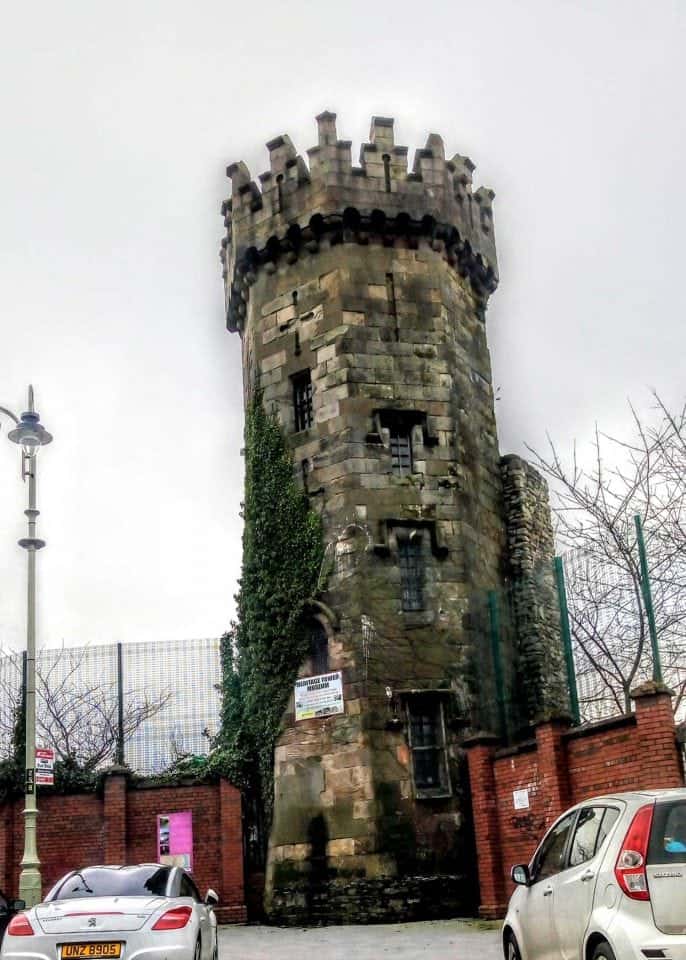
The prison’s most famous inmate was Theobald Wolfe Tone, one of the leaders of the failed 1798 United Irishmen rebellion. Tone was imprisoned here prior to his trial and execution in Dublin. Also held here was, then rebel, Eamon de Valera, later to be President of Southern Ireland.
The tower now houses a small World War I museum, which is only open by appointment.

Derry Girls Mural
A worldwide hit TV series Derry Girls this sitcom has been an inspiration for a new generation of Irish folks that grew up during the Troubles. The reality of British Army checkpoints, bomb warnings and peace walls are all exposed in the show along with the Catholic nuns and schools attended. The Derry Girls make us laugh at the absolute absurdity of the past.
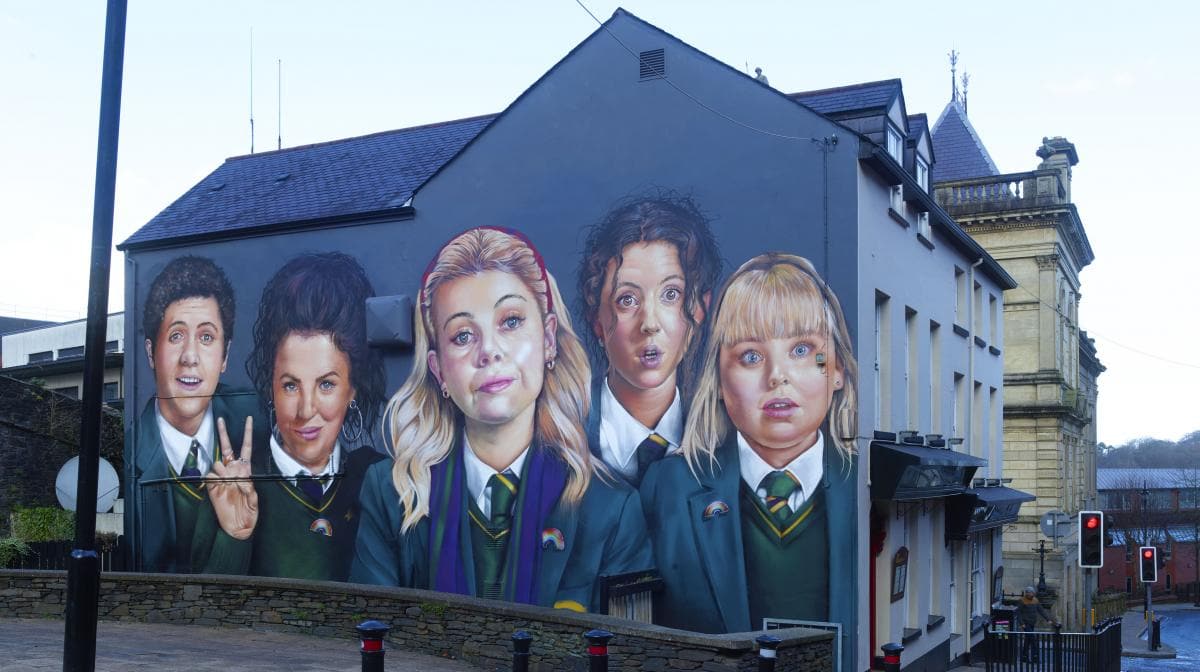
A mural of the show in the tradition of Irish murals in Derry was commissioned by Channel 4 and designed by the Derry-based social enterprise group UV arts. You can find the mural on the side of Badger’s Bar and Restaurant right in the heart of Derry with perfect views from the City walls of Derry. The address is 18 Orchard Street and features the cast of the hit show.
Derry Halloween events
If you get the opportunity the best place in the world to spend Halloween is in Derry. USA Today voted Derry the Best Halloween Destination in the World and it is the truth.
Halloween was invented by the Irish and originated in the ancient Gaelic festival of Samhain – which is pronounced sow win. This is the time of year when the walls between the worlds are thin and the spirits of the dead come back to walk the earth. Derry is the centre of some phenomenal celebrations like the Awakening of the Walls which is a trail you can walk along the ancient Derry walls full of supernatural installations and some outstanding performances. There are drummers, magicians, giant puppets, and the Return of the Ancients Parade. Everyone in Derry gets dressed up and involved in the celebrations.

Tourist Information Centre Londonderry
We highly recommend that you stop by the Tourist Information Centre they were incredibly knowledgable and helpful and this was where we got the recommendation to book Adrian as our tour guide and we couldn’t have been happier. They also have a little gift shop there with some really interesting items to pick up and take home with you.
Don’t forget to visit the Glens of Antrim while you are touring N. Ireland – it’s a true don’t miss
We had a fantastic two days in Derry and would go back again in a heartbeat. We had a brilliant dinner at the Quay West Winebar and because it was a Monday night, it was 30% off. Our total dinner bill with 4 Guinness, 1 cocktail, 2 steak dinners, 2 pasta dinners was a grand total of £44 now that can’t be beaten.
We discovered some lovely little cafes just up the road from our hotel and for breakfast, we paid around £4.50 for a full Irish with tea.
Where to stay in Derry
City Hotel Derry
We stayed in the ideally located City Hotel Derry which is very close to the Derry City Centre and we were very pleased with the location it was absolutely perfect for walking around Derry. The hotel has private parking below and we were able to leave our car there for the whole time we were there.

The hotel is a bit run down and in desperate need of some refurbishment, however, the staff were lovely and friendly and the place was immaculately clean. We can’t speak for the food because, to be honest, the reviews on that put us off so we didn’t eat there at all. But, for all of around £70 a night for the two of us it was great value.
Bishops Gate Hotel
If you want the ultimate in luxury take a look at the Bishop’s Gate Hotel the epitome of Edwardian elegance right in the Cathedral quarter. There is a lounge, fitness area, fine dining restaurant, and a Champagne bar.

Derry is a vibrant and historic city that offers visitors a wide range of activities and experiences. From exploring the ancient walls to enjoying traditional Irish music in local pubs, there is something for everyone in this charming town. Whether you’re interested in history, or culture, or simply want to relax and soak up the atmosphere.
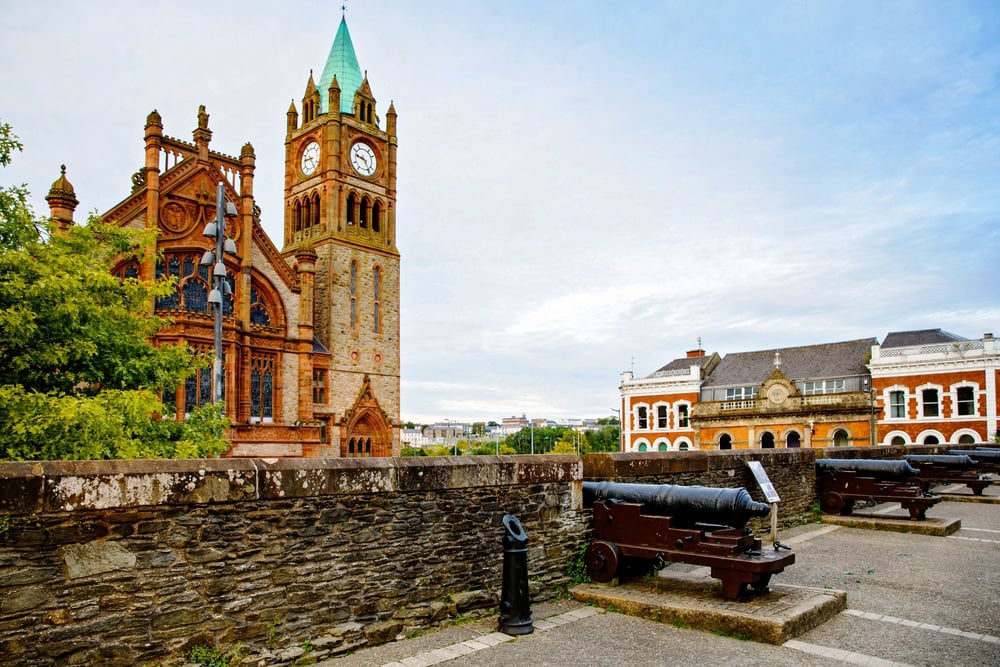
Take the time to visit the Seamus Heaney Homeplace in Bellaghy and discover how Seamus Heaney’s formative years in the Bellaghy area shaped his life and were a source of inspiration throughout his career. The exhibition is packed with poetry, photographs and stories that take you to the heart of Heaney’s life and work. It is located just under an hour from Derry.
Derry is a vibrant and historic city that offers visitors a wide range of activities and experiences. From exploring the ancient walls to enjoying traditional Irish music in local pubs, there is something for everyone in this charming town. Whether you’re interested in history, or culture, or simply want to relax and soak up the atmosphere.
Derry has it all. So why not plan your next trip to this beautiful part of Ireland and discover all that Derry has to offer? We guarantee you won’t be disappointed! All in all, it was an experience not to be missed and we can wholeheartedly recommend that you visit Derry – it’s a must-do when visiting Northern Ireland.
Derry has it all. So why not plan your next trip to this beautiful part of Ireland and discover all that Derry has to offer? We guarantee you won’t be disappointed! All in all, it was an experience not to be missed and we can wholeheartedly recommend that you visit Derry – it’s a must-do when visiting Northern Ireland.
You might also like
101 Landmarks in Northern Ireland
Essential guide to renting a car in Ireland
The Giant’s Causeway Tour how to visit for free
What is the best Causeway Coastal Route Itinerary?
60 Best Northern Ireland tourist attractions
What things to do in Derry did you discover?

